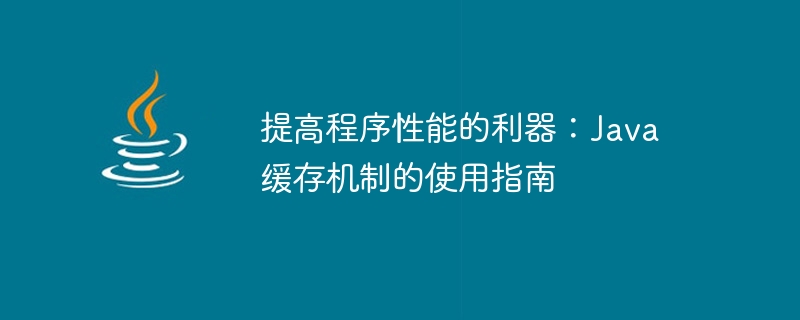Home >Java >javaTutorial >Java caching mechanism: a powerful tool for optimizing program performance
Java caching mechanism: a powerful tool for optimizing program performance
- PHPzOriginal
- 2024-01-23 08:01:05567browse

A powerful tool to improve program performance: A guide to using the Java caching mechanism
Abstract: In most software development projects, performance is usually a very important indicator. As a high-level programming language, Java's performance is also of great concern. In order to improve the execution efficiency of the program, we often use various methods, one of which is to use the caching mechanism. This article will introduce the guidelines for using the caching mechanism in Java, and provide examples to demonstrate how to apply the caching mechanism in specific code to improve program performance.
1. Why a caching mechanism is needed
In most applications, data access is usually a performance bottleneck. When we need to frequently obtain data from a database or other data sources, it takes time and resources to perform query operations every time. Moreover, we need to obtain the same data repeatedly even if the data does not change. At this time, if we can save the acquired data in memory and reuse it, we can greatly improve the performance of the program.
2. The basic principle of Java caching mechanism
The basic principle of Java caching mechanism is to store data in memory and access data by establishing key-value pairs. When you need to get data, first check whether the key-value pair of the data exists in the cache. If it exists, get the data directly from the cache; if it does not exist, get the data from the data source and save the data to the cache. for next time use.
3. Specific implementation of Java caching mechanism
- Use ConcurrentHashMap to implement caching
ConcurrentHashMap is a thread-safe hash table implementation class provided by Java. We can use ConcurrentHashMap to implement caching. The sample code is as follows:
import java.util.Map;
import java.util.concurrent.ConcurrentHashMap;
public class Cache {
private Map<String, Object> cache = new ConcurrentHashMap<>();
public Object get(String key) {
return cache.get(key);
}
public void put(String key, Object value) {
cache.put(key, value);
}
public boolean contains(String key) {
return cache.containsKey(key);
}
public void remove(String key) {
cache.remove(key);
}
public void clear() {
cache.clear();
}
}- Use Guava Cache to implement caching
Guava is an excellent Java tool library developed by Google. Contains a powerful caching library Guava Cache. Guava Cache provides rich caching functions, making it easy to read, update, and delete data. The sample code is as follows:
import com.google.common.cache.Cache;
import com.google.common.cache.CacheBuilder;
import java.util.concurrent.TimeUnit;
public class Cache {
private Cache<String, Object> cache;
public Cache() {
cache = CacheBuilder.newBuilder()
.expireAfterWrite(10, TimeUnit.MINUTES) // 设置缓存数据的过期时间
.build();
}
public Object get(String key) {
return cache.getIfPresent(key);
}
public void put(String key, Object value) {
cache.put(key, value);
}
public void remove(String key) {
cache.invalidate(key);
}
public void clear() {
cache.invalidateAll();
}
}4. How to use the caching mechanism to improve program performance
In actual projects, we can use the caching mechanism to improve program performance through the following steps:
- Determine the data that needs to be cached
First, we need to determine which data is suitable for caching operations. Generally speaking, data that requires frequent access and large amounts of data are suitable for caching. - Select an appropriate caching strategy
Choose an appropriate caching strategy based on the characteristics of the cached data and business needs, such as LRU (least recently used), LFU (least frequently used), etc. - Implement cache logic
Implement cache logic in the code, that is, check whether it exists in the cache before obtaining the data. If it exists, return the cached data directly. If it does not exist, obtain the data from the data source. and save to cache. - Update cache data
When the data changes, the data in the cache needs to be updated in a timely manner to maintain data consistency.
5. Summary
Java caching mechanism is one of the powerful tools to improve program performance. By rationally using the caching mechanism, we can reduce the number of accesses to the data source and improve the response speed and processing efficiency of the program. This article introduces the basic principles and specific implementation methods of the Java caching mechanism, and gives steps to use the caching mechanism to improve program performance. I hope this article will help readers understand and apply the caching mechanism and improve program development efficiency.
(1500 words)
The above is the detailed content of Java caching mechanism: a powerful tool for optimizing program performance. For more information, please follow other related articles on the PHP Chinese website!

